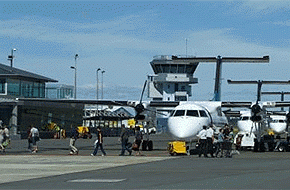
By Benje Patterson*

Jetstar ‘s entry into the New Zealand domestic market in June 2009 and its ensuing competition with Air New Zealand on main-trunk routes has marked the beginning of another era of cut-price domestic travel.
This article examines how much market share Jetstar has captured over the intervening years and also explains why improving regional air connectivity is good for the New Zealand economy.
According to data from Statistics New Zealand, the price of domestic air travel has risen by a mere 3.3 % over the past four years.
Over the same period general prices climbed by 8.8%, implying that the price of domestic air travel fell relative to most other expenses.
This relative improvement to the affordability of domestic air travel has massively expanded the size of the domestic market by bringing flying within the budgets of a wider cross-section of society.
Over the three years to June 2013, total domestic passenger numbers1 in New Zealand grew by 15%.
Decomposing this result shows that passenger number growth has been most rapid for Jetstar, up 59% off a low base over the past three years, while passenger numbers for Air NZ also grew a relatively healthy 8.4% over the same period.
Jetstar’s parent company, Qantas, claims that Jetstar’s share of the domestic airline market rose from 14.9% in December 2010 to 22.4% by June 2013.
Qantas estimates Jetstar’s market share by calculating the proportion of total domestic revenue passenger kilometres flown on Jetstar flights.
Revenue passenger kilometres are calculated by multiplying the number of passengers by the total kilometres each passenger flies.
Although this method of calculating market share adheres to standard international practice, the calculations are misleading in the New Zealand context because they underestimate the important role played by Air NZ in connecting regional centres.
A more appropriate measure of airline market share in New Zealand
When calculating market share in the New Zealand domestic airline market, it is preferable to use the passenger share method. As the name suggests, this method simply involves calculating the share of total domestic passenger numbers carried by the airline in question.
Using the passenger share method shows that Jetstar’s market share has grown from a mere 12.6% in December 2010 to 17.7% by June 2013 – but short of the 22.4% share claimed by Qantas.
The reason behind this divergence between the two methods can be explained by New Zealand’s geography.
Our nation’s rugged landscape and two main islands means that there are some very short airline routes, connecting mainly regional centres, which provide a convenient means of transportation. These short routes are relatively well-patronised, but would be underweighted by considering their contribution to revenue passenger kilometres. As Jetstar only flies on longer main-trunk routes, belittling the important contribution of short regional flights would underplay Air NZ’s dominance in connecting geographically-isolated parts of New Zealand.
A good example of one of these short regional routes is between Nelson and Wellington. Air NZ offers at least 10 flights a day in each direction on this route, typically utilising a 50 seat Bombardier Q300 aircraft. Although these 1,000 or so seats per day are a vital social and economic link between these two centres, they would receive little weight in a revenue passenger kilometre framework, as the flight distance between Nelson and Wellington is a mere 132 km.
There are numerous other examples of these types of shorter routes, but instead of highlighting their relevance one by one, I would like to take a step back and finish by briefly outlining why air connectivity between New Zealand’s regions is of economic importance. A good proxy for understanding air connectivity are passenger numbers because a rising number of passengers is a clear sign of increasing movements of people between regions.
Why is regional air connectivity important?
Air connectivity between geographically dispersed parts of New Zealand provides an economic enabling effect for entrepreneurial activity. In remote parts of the country, that do not have a location advantage, the availability of air travel helps create more efficient access to markets, people, ideas, and capital.
Even as the world becomes more digitally connected, there is still, at times, no substitute for face-to-face meetings, particularly in multilateral discussions between various parties. Efficient air connections can improve worker productivity by reducing downtime between meetings and freeing up more time to focus on other important tasks.
Good air linkages can also overcome issues relating to scale, by making it easier for small firms in regional New Zealand to connect with other firms across the country. This can allow geographically-removed firms in different regions to collaborate on projects.
As well as facilitating the movement of workers, regional air services also provide more options for freighting high value-added goods. This is particularly relevant for exporters of perishable goods, such as fresh seafood and cut flowers, where time to market is of the essence.
Finally, it would be remiss to ignore the role of air travel in promoting tourism. Convenient air linkages between smaller regions and cities raise the appeal of more remote locations for weekend getaways or stop-offs on a tour through the country.
Together, all of these enabling functions of air connectivity can help make it more attractive for businesses to locate in a region. In a similar vein, employers in well-connected regions, may find it easier to convince skilled staff to relocate, if staff know they are just a short flight away from friends and family elsewhere.
The issue as to whether these regional connections are offered by airlines in the first place comes down to profitability and the price an airline can charge per air kilometre. Although from a consumer’s perspective having competition is vital for keeping air prices low, Air New Zealand’s incumbent advantage in regional centres means that it is in a dominant competitive position. The relatively low scale of regional flights makes it uneconomic for new entrants to build a comprehensive regional network. As a result, Air NZ has been left in the stronger position of being able to sell tickets to people flying on both regional and main routes, while Jetstar needs to generate its profits from passengers flying between main-trunk airports.
--------------------------------------------------------------------------------------------
[1] Total domestic passenger numbers are calculated by aggregating passenger numbers for Jetstar and Air NZ taken from the Qantas Group and Air NZ annual reports.
--------------------------------------------------------------------------------------------
Benje Patterson is an economist at Infometrics. You can contact him here »


We welcome your comments below. If you are not already registered, please register to comment.
Remember we welcome robust, respectful and insightful debate. We don't welcome abusive or defamatory comments and will de-register those repeatedly making such comments. Our current comment policy is here.